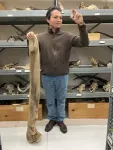(Press-News.org) From the 20-foot-long jawbones of the filter-feeding blue whale to the short, but bone-crushing, jaws of the hyena and the delicate chin bones of a human, the pair of lower jawbones characteristic of mammals have evolved with amazing variation.
But at first glance, having a single bone on each side of the head — which creates a stiff lower jaw, or mandible — doesn't appear to give mammals an advantage over other vertebrates, which have at least two and as many as 11 bones comprising each side of the lower jaw.
Crocodiles, for example, have an edge over hyenas when it comes to their bite strength relative to size, despite having around five bones on each side of the jaw. Snakes, which have an articulated lower jaw with around four bones, are able to open their mouths larger for their size than baleen whales and actually dislocate their jaws to ingest prey larger than their heads. Even extinct hadrosaurs, or duckbill dinosaurs, with six bones in their jaw, could masticate plants using oral movements that were more complex than those of today's cows.
So what advantage, if any, did two single jawbones — which in humans and other primates are fused at the chin into one solid mandible — give mammals?
That question motivated paleontologist Jack Tseng, assistant professor of integrative biology at the University of California, Berkeley, to construct a database of more than 1,000 vertebrate jaws — a small fraction of the approximately 66,000 living jawed vertebrate species on Earth — to systematically study whether mammalian jaws were a big advance over the multiply-boned jaws of fish, lizards, snakes and other non-mammals. He even printed 3D models of the lower jaws of many to test their sturdiness.
Surprisingly, the answer seems to be no — a lone lower jawbone on each side doesn't have a huge advantage over a jaw with multiple bones.
"Should we interpret the innovation of the mammalian jaw as a pure adaptation that enabled, in all ways, mammals to be more successful after the dinosaurs went extinct? I think the answer is no," Tseng said.
In fact, having multiple bones in the jaw gives an animal an advantage in biting: The bones may work together to provide flexibility and speed. Conversely, the single bone per side in mammals actually restricts the options available as mammals evolve. Paradoxically, this limitation has apparently not prevented mammals from adapting to eat and chew a variety of foods, rivaling the dietary diversity of vertebrates that have more than one bone in their jaw.
"There's this idea of a trade-off between the additional flexibility and maybe additional speed that you could achieve with multiple bones in a jaw — which essentially compounds or enlarges movement — and the increased stiffness or increased bite strength when you have a single bone in the jaw," Tseng said. "That sort of dichotomy between mammals and non-mammals supposedly enabled mammals to essentially become eaters of all things."
But that has never been rigorously tested until now, Tseng said.
"Nobody's tried to combine information from all of these groups of jawed vertebrates to ask general questions about how jaw shape and function are related," he said.
In the end, he concluded, the structure of the jaw has less to do with the function of the jaw in vertebrates than one might expect.
"Mammal jaws are more diverse in shape, yet more constrained in their biomechanical characteristics, compared to non-mammals. Mammal jaws can take, on average, more different shapes compared to non-mammal jaws, but those different shapes have narrower range of different mechanical properties than non-mammals," Tseng said. "This is a new observation that could potentially open up different ways of looking at mammal jaw biomechanics."
"The main finding was that, yes, indeed, mammals, given their single-boned lower jaw, have significantly higher strength or stiffness on average compared to any non-mammal jaw," he said. "This is true overall, regardless of what specific mammals are doing — it doesn't matter if you are a carnivore or an herbivore. Stiffness is not a predator trait or herbivore trait, it's a mammalian trait, a signature of the mammal jaw."
Tseng's study appeared last month in the journal Philosophical Transactions of the Royal Society B as part of a series on the evolution of the mammalian skull.
From jaw to ear
So why did mammals lose the extra bones in their lower jaw? Well, they didn't. Instead, the extra bones that vertebrates had in the lower jaw, which were clustered around the hinge between the lower and upper jaw, evolved into the mammalian inner ear, perhaps giving mammals better hearing than their vertebrate cousins.
"A solid, stiff jaw in mammals is thought to be a side effect of establishing a uniquely mammalian hearing system," Tseng said.
Coopting these jaw bones into the ear left mammals with only one lower jawbone per side, making for a rigid jaw that gave mammals some advantage in terms of stiffness — enough to crack bones, for example — but limited their descendants to variations on a single bone, even when a stiff lower jaw was not needed to eat soft food. Anteaters, for example, evolved a down-curving jaw that serves as a slot for their long tongue to slide through.
To date, this major evolutionary transition in mammals — to a complex inner ear, but simple jaw — has been studied primarily as it relates to the ear.
Tseng, who in the past has studied bone crushing animals like the hyena, wanted to look at the question from the jaw's point of view and an engineering perspective. To do this, he digitized two-dimensional jaw shapes from more 1,000 kinds of vertebrates, established the key characteristics of vertebrate jaws, and then simulated the mechanical performance of different jaw shapes — including plausible shapes not seen in nature — to determine how mammals and non-mammals compared across the range of all possible jaws in terms of strength and function. He found that both groups spanned the range, and thus seem able to adapt to a similar range of strength and function. However, mammalian jaws cluster more around stiffer shapes than non-mammals’ jaws.
Tseng plans to expand his database to more vertebrate species and also incorporate 3D scans of jawbones for a better biomechanical assessment of stiffness and strength.
He also hopes that others will investigate the role genetics plays in mammals' transition to a complex ear structure but a simple bone structure in the lower jaw, what the consequences of this transition were for mammalian evolution, and why evolution seems to have locked in this jaw trait in mammals.
"We hope our findings prompt some people to search for genetic bases for why this is a one-way street," he said. "A next step is to understand in what ways this characteristic decoupling of structure and function in mammals helped them adapt to new environments during key geologic times, such as the extinction of non-avian dinosaurs, as well as appearances of land bridges connecting continents that allowed greater mixing of different ecological communities."
Tseng's co-authors are Sergio Garcia-Lara and Emily Holmes of UC Berkeley, John Flynn of the American Museum of Natural History in New York, Timothy Rowe of the University of Texas at Austin and Blake Dickson of Duke University in North Carolina.
END
A jaw-dropping conundrum: Why do mammals have a stiff lower jaw?
Unlike other vertebrates, mammals have just one lower jawbone. Did that give them a survival advantage?
2023-06-27
ELSE PRESS RELEASES FROM THIS DATE:
New research by Sylvester Cancer shows unmet support needs can lead to worse clinical outcomes
2023-06-27
MIAMI, FLORIDA (June 27, 2023) – Cancer patients with unmet supportive care needs are more likely to experience worse clinical outcomes, including more emergency department (ED) visits and hospitalizations, according to new research from Sylvester Comprehensive Cancer Center at the University of Miami Miller School of Medicine.
The study, published June 21 in JAMA Network Open, also found that Black race, Hispanic ethnicity and factors such as anxiety, depression, pain, poor physical function and low health-related quality-of-life ...
Higher doses of oral semaglutide improves blood sugar control and weight loss
2023-06-27
CHAPEL HILL, N.C. – Diabetes is a progressive disease that affects one’s ability to control blood sugar levels. For many patients, the condition becomes more severe over time and blood sugar levels grow more difficult to manage. Glucagon-like peptide-1 (GLP-1) receptor agonists, such as semaglutide, have granted patients more control in lowering of blood sugar.
John Buse, MD, PhD, the Verne S. Caviness Distinguished Professor of Medicine in the Division of Endocrinology and Metabolism, and an international team of researchers have presented new findings about new higher-dose formulations ...
Age of those with mismatched biological sex and gender identity (gender dysphoria) is falling
2023-06-27
The age of those who are distressed because of a mismatch between their biological sex and their gender identity—known as gender dysphoria—has been steadily falling, reveals research published in the open access journal General Psychiatry.
And it’s lower for those assigned female sex at birth than those assigned male, the findings indicate.
Recent studies suggest that gender dysphoria is becoming more common, particularly among those assigned female sex at birth. But these studies have been hampered by small sample sizes, short monitoring periods, or outdated datasets.
In a bid to get round these limitations, the researchers drew on data submitted ...
Mediation’s role in parental disputes about child’s medical treatment may have been oversold
2023-06-27
The role of mediation in preventing disputes between parents and doctors about a seriously ill child’s medical treatment from escalating to litigation may be more limited than hoped for, suggests an analysis of rulings, published online in the Archives of Disease in Childhood.
It might have avoided only just under half of these published court cases heard since 1990 in England and Wales, the analysis suggests.
Contested medical treatment decisions for children litigated in the courts of England and Wales may be on the rise, say the researchers.
While 10 and 11 such ...
Ask us how to build the circular economy, say scientists
2023-06-27
Governments and companies planning to pursue the circular economy need to involve scientists more directly, states a new report published by the International Society for Industrial Ecology, and led by UCL’s Dr Stijn van Ewijk.
The report, published today, draws attention to the weight of relevant expertise found in the field of industrial ecology, a discipline that has been focusing on the minimisation of waste, predicting the impacts of new products, and designing environmentally friendly systems for decades.
The ...
DNA discovery may assist in fight against aggressive cancer
2023-06-27
In a significant development in the fight against fatal cancers, University of Otago researchers have pinpointed a key feature that leads to the aggressive spread of colon cancer.
Led by Associate Professor Aniruddha Chatterjee and Drs Euan Rodger and Rachel Purcell, researchers discovered abnormalities in the DNA instruction code that lead to the aggressive spread of colorectal (bowel) cancer – Aotearoa’s second highest cause of cancer death.
Dr Rodger says the finding – published in the Cell Press journal ...
Addressing health in areas characterized by persistent poverty
2023-06-27
The Center for Health Outcomes and Population Equity (HOPE) at Huntsman Cancer Institute and the University of Utah (the U), in partnership with the Montana State University Center for American Indian and Rural Health Equity (CAIRHE), received a grant for Cancer Control in Persistent Poverty Areas from the National Cancer Institute (NCI), part of the National Institutes of Health. The new grant is part of the National Cancer Moonshot, led by the Biden-Harris Administration, and it will bring together the expertise of the Center for HOPE and CAIRHE to expand their impact through two initiatives that ...
Toxic ideas online are spreading and growing through the use of irony, analysis shows
2023-06-26
Irony has become a medium for the spread of toxic ideas online, new analysis shows.
The use of irony is growing in both contemporary politics and radical online communities because it helps people to make sense of and navigate major political and economic changes, researchers have said.
Ideas, jokes, memes, images are emerging as an animating force for new social movements and are now inextricably intertwined with the rise of the alt-right.
The study says examining irony can help understand how recent influential political ...
Validation Institute confirms over $2,200 per member per year savings from Ochsner Digital Medicine
2023-06-26
June 26, 2023 - New Orleans - Ochsner Digital Medicine has achieved Validation for Savings by the Validation Institute, an independent non-profit organization. The Institute confirmed in a new propensity-matched study that members of Ochsner Connected Health’s chronic disease management program have lower per member per month costs than similar non-participants.
"The Validation Institute has recognized what our clients and thousands of Ochsner Digital Medicine members know – this digital platform empowers members to save money, which is achieved through managing their chronic conditions ...
Mayo Clinic uses genomic testing broadly for rare diseases, improves patient care
2023-06-26
ROCHESTER, Minn. ¾ A Mayo Clinic study published in Journal of Translational Medicine evaluated the use of genomic testing broadly for rare diseases. With the increased use of genomic testing such as multi-gene panels, exome sequencing and genome sequencing in the past decade, there is a greater opportunity to better diagnose and treat patients with rare diseases. According to the National Institutes of Health, as many as 10,000 distinct rare diseases exist and an estimated 25-30 million Americans are affected by one of them.
In the four-year Mayo Clinic study, researchers evaluated 1,152 patients with rare ...
LAST 30 PRESS RELEASES:
Making lighter work of calculating fluid and heat flow
Normalizing blood sugar can halve heart attack risk
Lowering blood sugar cuts heart attack risk in people with prediabetes
Study links genetic variants to risk of blinding eye disease in premature infants
Non-opioid ‘pain sponge’ therapy halts cartilage degeneration and relieves chronic pain
AI can pick up cultural values by mimicking how kids learn
China’s ecological redlines offer fast track to 30 x 30 global conservation goal
Invisible indoor threats: emerging household contaminants and their growing risks to human health
Adding antibody treatment to chemo boosts outcomes for children with rare cancer
Germline pathogenic variants among women without a history of breast cancer
Tanning beds triple melanoma risk, potentially causing broad DNA damage
Unique bond identified as key to viral infection speed
Indoor tanning makes youthful skin much older on a genetic level
Mouse model sheds new light on the causes and potential solutions to human GI problems linked to muscular dystrophy
The Journal of Nuclear Medicine ahead-of-print tip sheet: December 12, 2025
Smarter tools for peering into the microscopic world
Applications open for funding to conduct research in the Kinsey Institute archives
Global measure underestimates the severity of food insecurity
Child survivors of critical illness are missing out on timely follow up care
Risk-based vs annual breast cancer screening / the WISDOM randomized clinical trial
University of Toronto launches Electric Vehicle Innovation Ontario to accelerate advanced EV technologies and build Canada’s innovation advantage
Early relapse predicts poor outcomes in aggressive blood cancer
American College of Lifestyle Medicine applauds two CMS models aligned with lifestyle medicine practice and reimbursement
Clinical trial finds cannabis use not a barrier to quitting nicotine vaping
Supplemental nutrition assistance program policies and food insecurity
Switching immune cells to “night mode” could limit damage after a heart attack, study suggests
URI-based Global RIghts Project report spotlights continued troubling trends in worldwide inhumane treatment
Neutrophils are less aggressive at night, explaining why nighttime heart attacks cause less damage than daytime events
Menopausal hormone therapy may not pose breast cancer risk for women with BRCA mutations
Mobile health tool may improve quality of life for adolescent and young adult breast cancer survivors
[Press-News.org] A jaw-dropping conundrum: Why do mammals have a stiff lower jaw?Unlike other vertebrates, mammals have just one lower jawbone. Did that give them a survival advantage?





